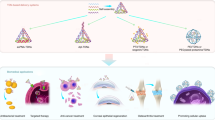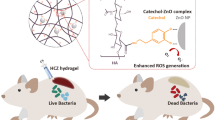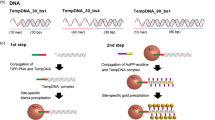Abstract
Emerging areas of nanotechnology hold the promise of overcoming the limitations of existing technologies for intracellular manipulation. These new developments provide approaches for the creation of chemical–biological hybrid nanocomposites that can be introduced into cells and subsequently used to initiate intracellular processes or biochemical reactions. Such nanocomposites would advance medical biotechnology, just as they are improving microarray technology and imaging in biology and medicine, and introducing new possibilities in chemistry and material sciences. Here we describe the behaviour of 45-Å nanoparticles of titanium dioxide semiconductor combined with oligonucleotide DNA into nanocomposites in vivo and in vitro. These nanocomposites not only retain the intrinsic photocatalytic capacity of TiO2 and the bioactivity of the oligonucleotide DNA (covalently attached to the TiO2 nanoparticle), but also possess the chemically and biologically unique new property of a light-inducible nucleic acid endonuclease, which could become a new tool for gene therapy.
This is a preview of subscription content, access via your institution
Access options
Subscribe to this journal
Receive 12 print issues and online access
$259.00 per year
only $21.58 per issue
Buy this article
- Purchase on Springer Link
- Instant access to full article PDF
Prices may be subject to local taxes which are calculated during checkout



Similar content being viewed by others
References
Bruchez, M. Jr, Moronne, M., Gin, P., Weiss, S. & Alivisatos, A.P. Semiconductor nanocrystals as fluorescent biological labels. Science 281, 2013–2016 (1998).
Chan, W.C.-W. & Nie, S.M. Quantum dot bioconjugates for ultrasensitive nonisotopic detection. Science 281, 2016–2018 (1998).
Taton, T.A., Mirkin, C.A. & Letsinger, R.L. Scanometric DNA array detection with nanoparticle probes. Science 289, 1757–1760 (2000).
Park, S.-J.T., Taton, T.A. & Mirkin, C.A. Array-based electrical detection of DNA with nanoparticle probes. Science 295, 1503 (2002).
Wei, Y., Cao, C., Jin, R. & Mirkin, C.A. Nanoparticles with Raman spectroscopic fingerprints for DNA and RNA detection. Science 297, 1536 (2002).
Mirkin, C.A., Letsinger, R.L., Mucic, R.C. & Storhoff, J.J. A DNA-based method for rationally assembling nanoparticles into macroscopic materials. Nature 382, 607–609 (1996).
Alivisatos, A.P. et al. Organization of 'nanocrystal molecules' using DNA. Nature 382, 609–611 (1996).
Perez, J.M., O'Loughin, T., Simeone, F.J., Weissleder, R. & Josephson, L. DNA-based magnetic nanoparticle assembly acts as a magnetic relaxation nanoswitch allowing screening of DNA-cleaving agents. J. Am. Chem. Soc. 124, 2856–2857 (2002).
Fujishima, A. & Honda, K. Electrochemical photolysis of water at a semiconductor electrode. Nature 238, 37 (1972).
Rajh, T. et al. Surface restructuring of nanoparticles: an efficient route for ligand-metal oxide crosslink. J. Phys. Chem. B 106, 10543–10552 (2002).
Rajh, T., Nedeljkovic, J., Chen, L.X., Poluektov, O. & Thurnauer, M.C. Improving optical and charge separation properties of nanocrystalline TiO2 by surface modification with vitamin C. J. Phys. Chem. B 103, 3515–3519 (1999).
Lewis, F.D. et al. Direct measurement of hole transport dynamics in DNA. Nature 406, 51–34 (2000).
Conwell, E.M. & Rakhmanova, S.V. Polarons in DNA. Proc. Natl Acad. Sci. USA 97, 4556–4560 (2000).
Von Sonntag, C. The Chemical Basis of Radiation Biology (Taylor & Francis, Philadelphia, 1987).
Yun, C.S., Khitrov, G.A., Vergona, D.E., Reich, N.O. & Strouse, G.F. Enzymatic manipulation of DNA-nanomaterial constructs. J. Am. Chem. Soc. 124, 7644–7645 (2002).
Rajh, T., Ostafin, A.E., Micic, O.I., Tiede, D.M. & Thurnauer, M.C. Surface modification of small particle TiO2 colloids with cysteine for enhanced photochemical reduction: An EPR study. J. Phys. Chem. 100, 4538–4545 (1996).
Rajh, T., Saponjic, Z.V. & Micic, O.I. Reactions of hydrous titanium-oxide colloids with strong oxidizing agents. Langmuir 8, 1265–1270 (1992).
Rajh, T., Thurnauer, M.C., Thiyagarajan, P. & Tiede, D.M. Structural characterization of self-organized TiO2 nanoclusters studied by small angle neutron scattering. J. Phys. Chem. B 103, 2172–2177 (1999).
Boncheva, M., Scheibler, L., Lincoln, P., Vogel, H. & Akerman, B. Design of oligonucleotide arrays at interfaces. Langmuir 15, 4317–4320 (1999).
Fillinger, A. & Parkinson, B.A. The adsorption behavior of a rutheninm-based sensitizing dye to nanocrystalline TiO2 - Coverage effects on the external and internal sensitization quantum yields. J. Electrochem. Soc. 146, 4559–4564 (1999).
Rajh, T. et al. Spin polarization mechanisms in early stages of photoinduced charge separation in surface-modified TiO2 nanoparticles. Chem. Phys. Lett. 344, 31–39 (2001).
Pichon, B. & Christophe, D. An in vitro transcription system for the study of thyroid-specific transcription. Anal. Biochem. 261, 233 (1998).
Lai, B., Maser, J., Paunesku, T. & Woloschak, G.E. Report on the workshop of biological applications of X-ray microbeams. Int. J. Radiat. Biol. 78, 749 (2002).
Paunesku, T. et al. Identification of genes regulated by UV/salicylic acid. Int. J. Radiat. Biol. 76, 189 (2000).
Acknowledgements
T.P., N.S., M.P., J.O. and G.W. were supported by National Institute of Health grants CA81375, CA73042, and NS21442; T.P., T.R., G.W., J.M., S.V., N.S., B.L., M.T. and G.W. were supported by the US Department of Energy, Office of Basic Energy Sciences under contract No. W-31-109-Eng-38.
Author information
Authors and Affiliations
Corresponding author
Ethics declarations
Competing interests
The authors declare no competing financial interests.
Rights and permissions
About this article
Cite this article
Paunesku, T., Rajh, T., Wiederrecht, G. et al. Biology of TiO2–oligonucleotide nanocomposites. Nature Mater 2, 343–346 (2003). https://doi.org/10.1038/nmat875
Received:
Accepted:
Published:
Issue Date:
DOI: https://doi.org/10.1038/nmat875
This article is cited by
-
Development of Fe3O4 core–TiO2 shell nanocomposites and nanoconjugates as a foundation for neuroblastoma radiosensitization
Cancer Nanotechnology (2021)
-
Formation mechanism of the rutile-phase of TiO2 nanorods on Ti foil substrate by gel-calcination method
Journal of Sol-Gel Science and Technology (2018)
-
Effect of heating on the structural and optical properties of TiO2 nanoparticles: antibacterial activity
Applied Nanoscience (2018)
-
Intracellular in situ labeling of TiO2 nanoparticles for fluorescence microscopy detection
Nano Research (2018)
-
Ag-doping regulates the cytotoxicity of TiO2 nanoparticles via oxidative stress in human cancer cells
Scientific Reports (2017)



